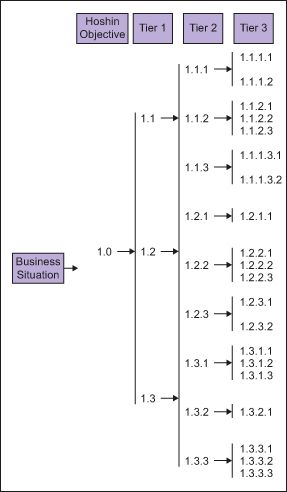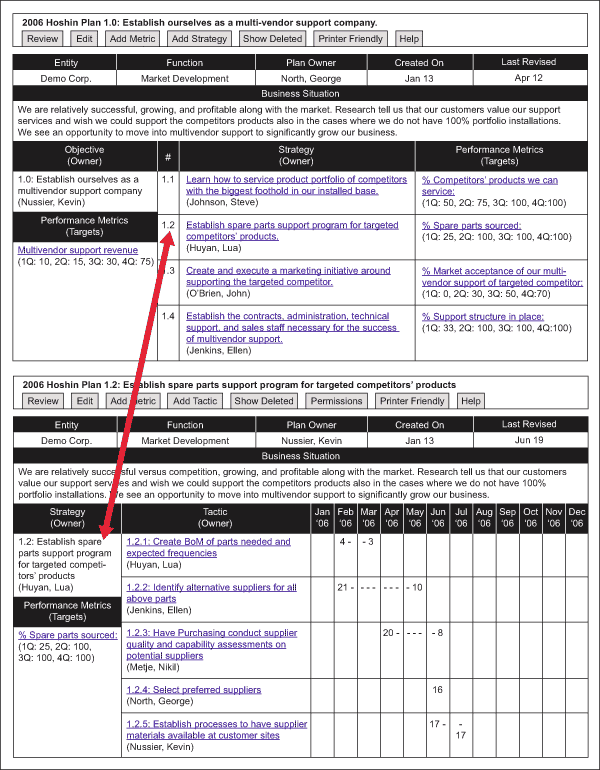
Hoshin planning, which focuses on achieving a vital annual stretch goal, has been used successfully by Toyota and other companies in Japan since the 1960s and some top-tier companies in the United States and elsewhere. However, interest in using Hoshin planning now appears to be growing. Bank of America, for example, has made a very visible display of its use recently. And as more large U.S. businesses use Hoshin, it is almost certain that they will pressure suppliers in their supply chain to also adopt it.
Hoshin’s adoption by U.S. businesses has been relatively slow because many organizations did not have the management and process infrastructure in place to support Hoshin planning. Another reason is that early adopters saw its benefits and did not tout its use as they saw it as contributing to their competitive advantage.
Since an increasing number of organizations appear to be modeling their business practices on the Toyota system. In time, the use of Hoshin planning is likely to be more common than not. So what exactly is Hoshin, Hoshin Kanri and a Hoshin plan? Loosely interpreted from Japanese, the meaning of the word hoshin in English is “setting a direction or setting an objective.” Kanri translates as “management.” Together the meaning is “the management of objectives.”
In current use, Hoshin Kanri, used interchangeably with Hoshin planning, refers to the process through which:
- Top management identifies a compelling business situation (need or opportunity), that is linked to the company’s three-to-five-year strategic plan and vision.
- A strategically important annual “stretch” objective to meet the need is identified.
- Plans are developed to achieve the objective.
- Monitoring processes are established and used to ensure that planned actions are accomplished and, if necessary, available to modify the plan.
- Metrics are used to assess progress and to determine if the objective has been achieved.
- Year-over-year lessons learned are used to continually improve the Hoshin planning process and to further develop employee skills.
What Is Unique About Hoshin Planning?
Six things are unique about the Hoshin planning process and need to be thoroughly understood and used for success. They are:
1. The plan flows from two sources, an annual “state of the business” review and the Hoshin objective. The annual “state of the business” review is conducted by the most senior leaders of the organization. In this review, data about the external and internal environments are examined in light of their impact on the three-to-five-year strategic plan. The output of the review is known as the “business situation” and is a short description of the major business issue that top management will focus on for the coming year as it relates to the three-to-five-year strategic plan. Once developed, the business situation is kept highly visible as the Hoshin plan is developed. The business situation serves as the reference point for all of the plan’s strategies, objectives and tactics
The Hoshin objective is an annual “stretch” goal that, when achieved, will have a significant impact on the business situation that was identified in the annual state of the business review. The Hoshin objective (and all other sub-objectives) have the following four elements:
- A description of the outcome expressed in a manner that allows it to be measured.
- Metrics that can be used to measure progress and to determine that the objective has been met.
- A timetable for completion.
- A person who is accountable for completing the objective or tactic.
2. The Hoshin plan is comprised of a series of hierarchical objectives that are derived from a series of multiple ends/means analyses. Typically the Hoshin objective is labeled 1.0. The question is then asked, “what three or four things must be achieved to accomplish 1.0?” The answers become the first tier of subordinate objectives, these are labeled 1.1, 1.2, 1.3.
Next, as with the Hoshin objective, each tier’s sub-objectives has an accountable person, the outcome statement, metrics and timetable for completion down to the lowest assignable task level. This ends/means process enables direct “line of sight” from the lowest level task, right through the hierarchy of objectives to the Hoshin objective itself. Figure 1 below illustrates the several tiers of sub-objectives.

The linkage between objectives and sub-objectives is illustrated in the Hoshin plan templates shown in Figure 2 below.

3. Use “catchball” to help develop the cascade of subordinate objectives.Catchball describes a communication process in which parties engage in a series of information exchanges about the means for achieving a particular objective. The purpose for the exchange is to build consensus around the best approach for achieving an objective. Catchball is based on the belief that the best approach will evolve from the back and forth exchange of information between the person who is responsible for achieving the objective and the persons who will be most influential in achieving it. The secondary benefit from using catchball is a higher degree of commitment to achieve the objective.
4. Communicate the plan to everyone who will be involved. A special effort should be made to communicate with persons on whom the success of the plan depends and people who will be implementing the plan and working on its various objectives and tactics. Plan to communicate as a continuing activity to keep everyone involved and up to date on any changes to the plan.
5. Monitor the plan as part of regular management meetings and be prepared to act when the plan shows signs of going off track. Some activities may require weekly or even daily monitoring.
6. Hold Monthly, Quarterly and Annual review meetings to keep the senior leadership informed on progress, to resolve issues that may require intervention, to ensure the planned activities are occurring as planned, to do root cause analysis and take corrective actions when necessary.
These elements are consistently shown to be major factors that differentiate success from failure with Hoshin planning. They seem simple, they seem obvious and they seem like common sense. In reality, they are often taken for granted and therefore overlooked with predictable and unfortunate results.